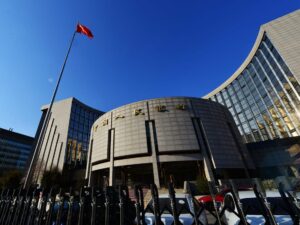>>REAL-TIME UPDATES IN THE WIRE. CLICK HERE<<<
China cut its benchmark lending rate and lowered the reference rate for home mortgage loans by a bigger margin, as the world’s second-largest economies boosts efforts to revive an economy hobbled by a property crisis and a resurgence of COVID-19 cases.
The one-year loan prime rate (LPR) was lowered by 5 basis points (bps) to 3.65% at the People’s Bank of China’s monthly fixing on Monday, while the five-year LPR was slashed by 15 bps to 4.30%.
The one-year LPR was last reduced in January. The five-year LPR, which China’s home mortgage rates are based on, which was last lowered in May.
The LPR cuts come after the central bank surprised the market last week by cutting two key policy rates – the interest rates on one-year medium term lending facility (MLF) rate and the rate on seven-day reverse repurchase agreement, after a string of data showed the economic recover unexpectedly slowed in July amid persistent disruptions caused by Covid resurgence.
Last week, the State Council, the country’s cabinet, said at a meeting that the authority will continue to push down borrowing cost for the corporate sector and rate on consumer loans and step up financial support to the real economy.
Goldman Sachs lowered China’s 2022 full-year GDP growth forecast to 3.0% from 3.3% previously, far below Beijing’s target of around 5.5%.
Analysts say the bigger cut to the five-year LPR underlines efforts by policymakers to stabilize the struggling housing market after a string of defaults among developers and a slump in home sales hammered consumer demand.
China’s credit growth slowed sharply in July and came in far below market expectations, and in particular, leverage ratio in the household sector declined significantly. New medium- and long-term loans to the household sector, mostly mortgage loans, decreased significantly from the same period in previous years. The bigger cut to five-year LPR is mainly aimed at bolstering home mortgage demand in a bid to offset the negative impact of a wide-spread mortgage boycott, said Li Chao, chief economist at Zheshang Securities, at a note on Monday.
The cut to five-year LPR will help further guide financial institutions to lower rates on medium- and long-term loans and increase attractiveness of low-cost funding to the corporate sector, said Liang Si, researcher at Bank of China.
The LPR cut was necessary, “but the size of the reduction was not enough to stimulate financing demand,” said senior China strategist at ANZ, Xing Zhaopeng, who expects the one-year LPR could be cut further.
Goldman Sachs economists also predicted more easing, but noted that policymakers were facing a testing time.
The economists said the PBOC might not be in a “rush to deliver more interest rate cuts,” because of “rising food prices and potential spillover effects from developed markets’ monetary policy tightening”.

